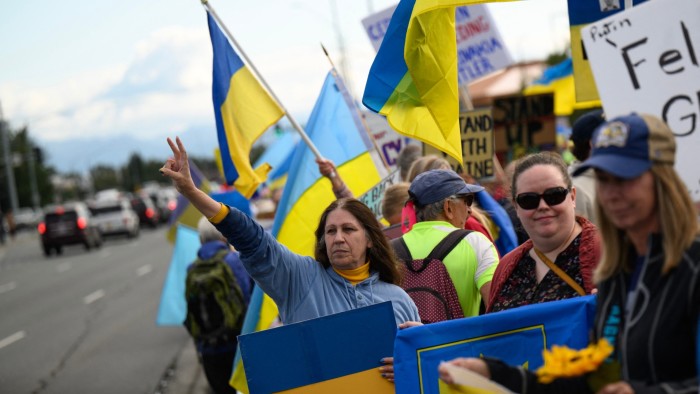Father Vasyl Mutka stood before the altar of St Nicholas of Myra church on Thursday morning, chanting a prayer for peace in his native Ukraine and pausing for only the briefest of breaths. The smell of incense hung in the air.
It was Mutka’s day off and the pews of the small wooden church in Anchorage were empty. These were his private prayers.
On Friday, presidents Donald Trump of the US and Vladimir Putin of Russia are set to meet at a military base just outside of the city to sound each other out and see whether peace might be possible.
“May God give the right words to President Trump,” said Mutka, who left Ukraine to come to the US in 2009. “And Putin be open to accept this message.”
As the host of a potentially historic summit between the leaders of Russia and the US, Alaska is steeped in symbolism. The Arctic state was purchased by the US from Russia in 1867 for $7.2mn — a bargain even in those days.
Traces of Russian influence can still be found in the place names, such as Kasilof, Ninilchik, and the enduring presence of the Orthodox Church, which counts about 50,000 followers in the state.
And like Alaska, Mutka’s church, with its steepled roof and onion dome tops, is also a place where east meets west. An eastern Catholic church of Byzantine rite, it is what he calls a “bridge” that is in communion with the pope but draws much of its symbolism and practices from the eastern Orthodox Church.
Today, Mutka’s parish serves 13 families, most of whom are Americans with roots in central and eastern Europe.
But Russia’s full-scale invasion of Ukraine in 2022 has brought a new wave of Ukrainian refugees into the state. More than 1,000 have settled here, 500 of whom are in Anchorage, said Zori Opanasevych, executive director of the New Chance Ukrainian Relief Program, a local non-profit helping refugees. For the second time, Putin is now coming to them.
They have mixed feelings about it, said Opanasevych.
Born in Ukraine, Opanasevych herself came to the US as a refugee in the 1990s. She said the local Ukrainian community reacted to the news of the summit with a combination of confusion and frustration — but also hope. “Even though they might not like it, they are still also hopeful that, ‘what if this time it works?’ We are hoping for the best. We have to,” she said.
The US president has sought to dampen expectations ahead of the meeting, describing it as “feel-out meeting” and not ruling out the possibility that it would fail. But both Trump and Putin have a habit of surprising the world.
“We’re going to find out where everybody stands. And I’ll know within the first two minutes, three minutes, four minutes or five minutes,” Trump said on Thursday.
Ukrainian President Volodymyr Zelenskyy will not be attending the summit. But if the tête-à-tête goes well, Trump has said he would seek to broker a trilateral meeting with the Ukrainian leader.
On Thursday afternoon, hundreds of local residents rallied in support of Ukraine at an intersection of Anchorage’s East Northern Lights Boulevard, waving the country’s blue and yellow flag. A small brass band played Bella Ciao, the Italian folk song adopted by the anti-fascist resistance during the second world war. Passing cars honked their horns.
“They are trying to make decisions, agreements, without Ukraine being involved,” said Anna Koraa, who moved to the US from Ukraine in 2019. Her mother, Olena Lazar, left Zaporizhzhia — one of the four Ukrainian regions Moscow claims, but does not fully occupy — and came to Alaska shortly after the war began.
Lazar is deeply sceptical about Friday’s talks. “He won’t stop until he takes all of Ukraine,” she said of the Russian leader.
The summit will mark the first time Putin has met a US leader since the 2022 invasion. The two presidents are to meet at Elmendorf Air Force Base on the north-eastern corner of Anchorage.

On Thursday evening as the Alaska summer sun was still high in the sky, the nearby St Innocent Russian Orthodox Church held a prayer service for peace.
Inside the wooden church, topped with baby blue onion domes, five clergymen gathered in a horseshoe formation in front of the altar. One, in floor-length blue robes, swung a thurible of incense back and forth like a metronome.
After the service, a handful of the reporters who had descended on Anchorage for the summit gathered around Alexei Trader, the archbishop of Sitka and Alaska — a diocese of the Orthodox Church of America which broke away from the Russian church in the 1970s.
A reporter asked for his views on Trump’s pursuit of peace. “I regard Trump as a president who has a political agenda, like all politicians,” said Trader. “I hope he seeks peace.”
What about Putin?
“Repentance is good. It’s good to change one’s mind. It’s good to stop hurting people. And that is, that’s the message I can give,” the archbishop said. “As for Putin and his soul — I’ll leave that elsewhere.”
Read the full article here
